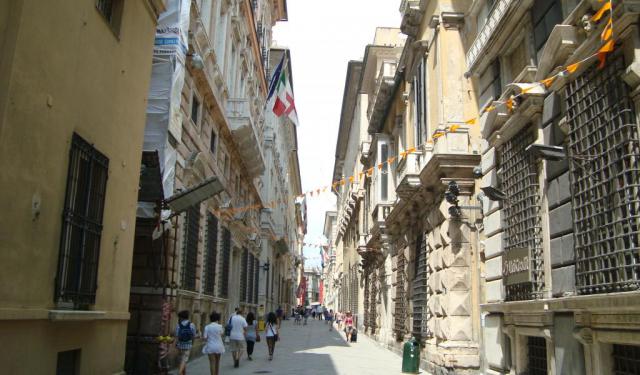
Palazzo Lomellino (Lomellino Palace), Genoa
The Podestà, or Nicolosio Lomellino, palace is a building at Via Garibaldi number 7.
It was built between 1559 and 1565 by Giovanni Battista Castello, known as "il Bergamasco", in collaboration with Bernardino Cantone at the behest of Nicolosio Lomellino, a highly influential relative of Prince Andrea Doria. In the early 17th century the palace was taken over by the Centurione family who carried out its internal restructuring. Eventually, the property fell into the hands of Andrea Podestà, who served as a mayor of Genoa several times from 1866 to 1895.
The façade, designed by il Bergamasco, is enlivened by a rich stucco decoration, with winged female herms supporting the string course on the ground floor; ribbons and drapes holding trophies of arms on the first floor; and garlands and masks crowning the windows, with classical figures within oval medallions, on the second. While most of the stucco decoration is attributed to Marcello Sparzo from Urbino, the festive stucco apparatus of the oval-shaped atrium, introducing the latest Mannerist culture to Genoa, was by il Bergamasco himself.
The oldest pictorial work in the building is the cycle of frescoes created in 1623-1624 by the Genoese painter Bernardo Strozzi. For years, it was hidden from view by a thick layer of plaster and false ceiling following a dispute with the client, Luigi Centurione, who had bought the building in 1609 from Nicolosio Lomellino. Uncovered in 2002, the fresco, still unfinished, offers a rare opportunity to observe the grid and the preparatory drawing made with black chalk.
On the second, main floor, the mythological-themed decoration from the early 18th century provides great example of the Genoese late Baroque. In the hall, decorated by Tommaso Aldrovandini, there are five canvases with Stories of Diana, created by the Bolognese painter Marcantonio Franceschini.
It was built between 1559 and 1565 by Giovanni Battista Castello, known as "il Bergamasco", in collaboration with Bernardino Cantone at the behest of Nicolosio Lomellino, a highly influential relative of Prince Andrea Doria. In the early 17th century the palace was taken over by the Centurione family who carried out its internal restructuring. Eventually, the property fell into the hands of Andrea Podestà, who served as a mayor of Genoa several times from 1866 to 1895.
The façade, designed by il Bergamasco, is enlivened by a rich stucco decoration, with winged female herms supporting the string course on the ground floor; ribbons and drapes holding trophies of arms on the first floor; and garlands and masks crowning the windows, with classical figures within oval medallions, on the second. While most of the stucco decoration is attributed to Marcello Sparzo from Urbino, the festive stucco apparatus of the oval-shaped atrium, introducing the latest Mannerist culture to Genoa, was by il Bergamasco himself.
The oldest pictorial work in the building is the cycle of frescoes created in 1623-1624 by the Genoese painter Bernardo Strozzi. For years, it was hidden from view by a thick layer of plaster and false ceiling following a dispute with the client, Luigi Centurione, who had bought the building in 1609 from Nicolosio Lomellino. Uncovered in 2002, the fresco, still unfinished, offers a rare opportunity to observe the grid and the preparatory drawing made with black chalk.
On the second, main floor, the mythological-themed decoration from the early 18th century provides great example of the Genoese late Baroque. In the hall, decorated by Tommaso Aldrovandini, there are five canvases with Stories of Diana, created by the Bolognese painter Marcantonio Franceschini.
Sight description based on Wikipedia.
Want to visit this sight? Check out these Self-Guided Walking Tours in Genoa. Alternatively, you can download the mobile app "GPSmyCity: Walks in 1K+ Cities" from Apple App Store or Google Play Store. The app turns your mobile device to a personal tour guide and it works offline, so no data plan is needed when traveling abroad.
Palazzo Lomellino (Lomellino Palace) on Map






Sight Name: Palazzo Lomellino (Lomellino Palace)
Sight Location: Genoa, Italy (See walking tours in Genoa)
Sight Type: Attraction/Landmark
Guide(s) Containing This Sight:
Sight Location: Genoa, Italy (See walking tours in Genoa)
Sight Type: Attraction/Landmark
Guide(s) Containing This Sight:
Walking Tours in Genoa, Italy
Create Your Own Walk in Genoa
Creating your own self-guided walk in Genoa is easy and fun. Choose the city attractions that you want to see and a walk route map will be created just for you. You can even set your hotel as the start point of the walk.
Rolli Palaces Walking Tour
The Rolli di Genova – or, more precisely, the Rolli degli alloggiamenti pubblici di Genova (Italian for "Lists of the public lodgings of Genoa") – were first established in the Republic of Genoa in 1576. Originally, these official lists included private palaces and mansions belonging to the most distinguished local families, which - if chosen through a public lottery - were obliged... view more
Tour Duration: 1 Hour(s)
Travel Distance: 0.4 Km or 0.2 Miles
Tour Duration: 1 Hour(s)
Travel Distance: 0.4 Km or 0.2 Miles
Genoa Introduction Walking Tour
Petrarch, an Italian poet of the early Renaissance known as the "father of humanism," called Genoa "La Superba" (The Proud One). Genoa is deservedly proud of her maritime glory and unique architecture.
From the 11th century until the late 18th century, the city became a leading economic and military power in Europe. It was one of the wealthiest cities in the world through... view more
Tour Duration: 2 Hour(s)
Travel Distance: 3.8 Km or 2.4 Miles
From the 11th century until the late 18th century, the city became a leading economic and military power in Europe. It was one of the wealthiest cities in the world through... view more
Tour Duration: 2 Hour(s)
Travel Distance: 3.8 Km or 2.4 Miles


